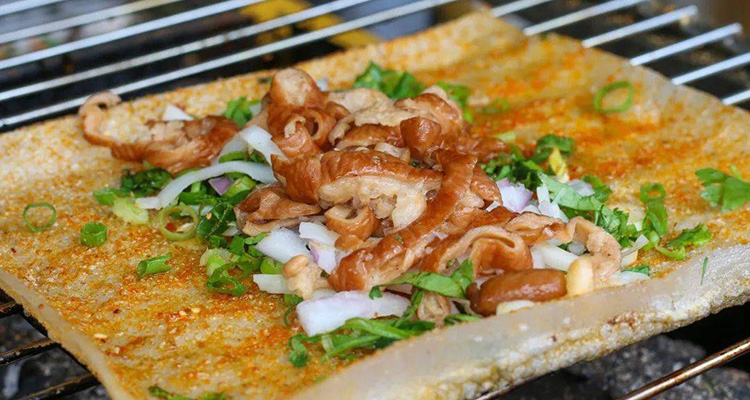Grilled Tiao-Pi: Spicy Sichuan-Chongqing Night Snack
Introduction:
When night falls, Sichuan and Chongqing night markets wake up, filling the air with irresistible smoky, spicy aromas. Among many tempting street foods, one humble snack has won hearts online and on the street alike: Grilled Tiao-Pi. Made from sweet potato starch sheets, it’s brushed with chili oil and spices, charred over coals, then topped with scallions, houttuynia (fish mint), pickled radish, crushed peanuts and more. The result: crispy outside, chewy inside, and boldly numbing-spicy—the perfect way to sample local late-night food culture.
1. Birth in the Mountain City Street Life: Origins and History
Grilled Tiao-Pi didn’t come from imperial kitchens—it grew from everyday ingenuity in Sichuan and Chongqing. Sweet potatoes were a common, storable crop, and locals turned sweet potato starch into thin sheets called tiao-pi. Initially boiled or stir-fried, someone discovered that grilling these sheets over charcoal transforms their texture and flavor. As vibrant night markets and a strong late-night eating culture developed, this simple, flavorful snack spread quickly from household kitchens to street stalls and, more recently, social media, becoming a national food trend.
2. More Than a Snack: Cultural Meaning
In Sichuan and Chongqing, late-night eating is social life and attitude. Grilled Tiao-Pi embodies that relaxed, vibrant “smoky” culture. Affordable and popular with students and night-shift workers, it appears at stalls around night markets, university districts, and residential neighborhoods—an ideal window into local daily life. Watching a vendor skillfully brush, flip, and season the tiao-pi while you wait for a steaming serving is a convivial experience you won’t get in a fine-dining restaurant. Tasting it is tasting the lively, inclusive spirit of the region.

3. Simple Roots: The Core Ingredient
The soul of Grilled Tiao-Pi is the tiao-pi itself—thin sheets made from sweet potato starch and water. High-quality dried tiao-pi is pale gray-white, translucent and thin, with a faint sweet potato aroma. Once soaked, it becomes soft and elastic. That sweet-potato starch structure is what creates the signature “crispy outside, chewy inside” texture after grilling. Equally important are Sichuan flavor elements—chili, Sichuan peppercorn, cumin—and finishing garnishes like scallions, cilantro, houttuynia (fish mint), pickled radish and crushed peanuts, which together build the snack’s layered taste.
4. Art on the Flames: How It’s Made
Watching a vendor grill tiao-pi is part of the pleasure. The process looks simple but demands precise heat control. First, soft, moistened sheets are laid flat on a wire rack and held over glowing charcoal. Intense heat quickly evaporates surface moisture with a sizzle. The vendor brushes on glossy chili oil and sprinkles Sichuan pepper powder, salt, and cumin. Tiny bubbles form across the sheet, edges char and curl, and the aroma intensifies. Depending on the order, fillings like pickled radish, minced meat, or pork loin can be tucked inside, or plentiful toppings are sprinkled on. A quick turn ensures even charring; when the snack is bronzed and fragrant, it’s skewered and ready to eat.

5. A Flavor Collision: Taste and Texture
A hot bite of Grilled Tiao-Pi delivers layered sensations. First comes crunch—the perfectly charred surface offers a toasty crispness. Then the chew—the interior becomes soft, slightly sticky and springy, similar to rice cake but lighter and more translucent. Flavor hits next: numbing Sichuan pepper and aromatic chili lead, while cumin and grilling notes add depth. Pickled radish refreshes, peanuts add crunch, scallions add bite, and houttuynia contributes a cool, herbal finish—balancing oil and enriching complexity. This contrast of crispy, chewy, spicy, numbing, tangy and crunchy is addictive.
6. How to Eat It: Authentic Serving Tips
Buy Grilled Tiao-Pi and eat it hot. Vendors usually secure it with bamboo skewers for easy handling. Blow on it briefly, then take a confident bite to enjoy crisp, soft, and filling layers together. The tiao-pi’s elasticity may create a pleasant tugging feel—part of the fun. Pair it with an ice-cold local soy milk or beer to cool the spice. Stuffed versions offer surprise bites with different fillings in each mouthful.

7. Traveler Tips: Where and How to Order
- Where to go: Head to Sichuan and Chongqing night markets, food streets, university areas, or busy neighborhood stalls after 8–9 pm. Stalls with long lines are usually reliable.
- How to order: You’ll often see “plain” (vegetarian) or filled options. First-timers should try plain to appreciate the base flavor, then move on to versions with pickled radish, minced meat, or sausage. If you dislike houttuynia, politely tell the vendor.
- Spice level: Local “mild” can still be quite spicy—ask vendors to reduce chili if needed.
- Hygiene: Choose busy, visibly clean stalls for safer dining.
8. Taste at Home: Easy Homemade Grilled Tiao-Pi
If you miss the flavor after leaving Sichuan or Chongqing, try this home method:
- Ingredients: dried tiao-pi (or sweet potato starch sheets), chili powder, Sichuan pepper powder, cumin, light soy sauce, sugar, salt, scallions, cilantro, crushed roasted peanuts, pickled radish.
- Steps:
- Soak dried tiao-pi in warm water 15–20 minutes until soft.
- Make the sauce: mix chili powder, Sichuan pepper powder, cumin, and white sesame; pour hot oil to release aromas, then add soy sauce, a little sugar and salt.
- Drain tiao-pi and pat dry.
- Heat a nonstick pan or griddle with a little oil; cook on medium-low.
- When small bubbles appear, flip and brush the prepared sauce.
- Cook until both sides are golden and slightly charred; top with scallions, peanuts and pickled radish.
- Fold or roll, serve immediately. Alternatively, bake in a preheated oven at 200°C (390°F) for about 10 minutes.

Final note:
Grilled Tiao-Pi is a delicious, approachable way to experience Sichuan-Chongqing night-life flavors. Whether you hunt it down at a bustling night market or recreate it at home, this smoky, numbing-spicy snack tells a story of local resourcefulness and communal eating—one irresistible bite at a time.


